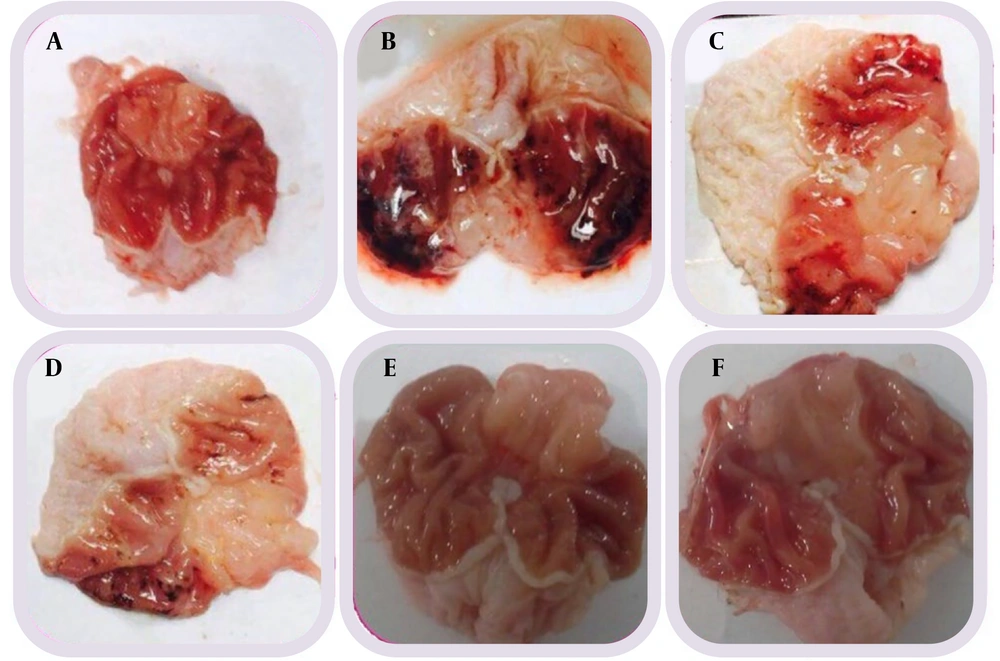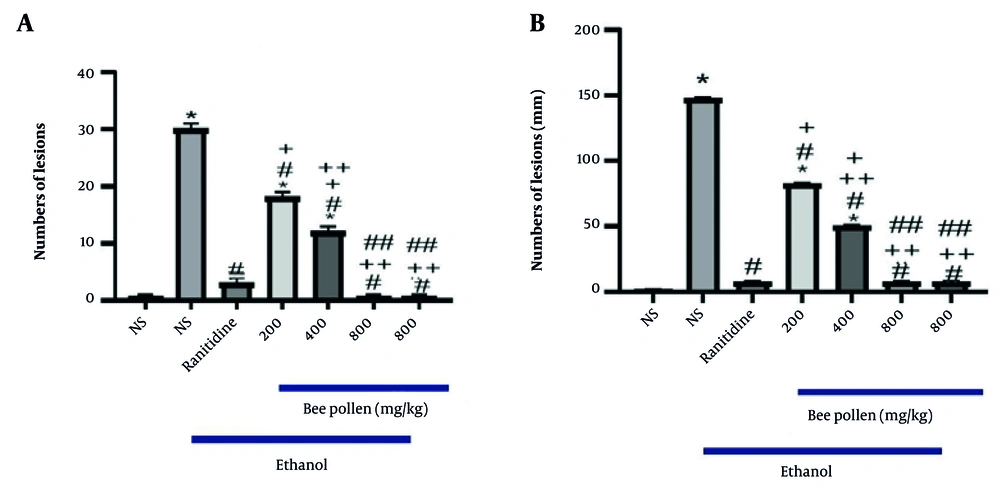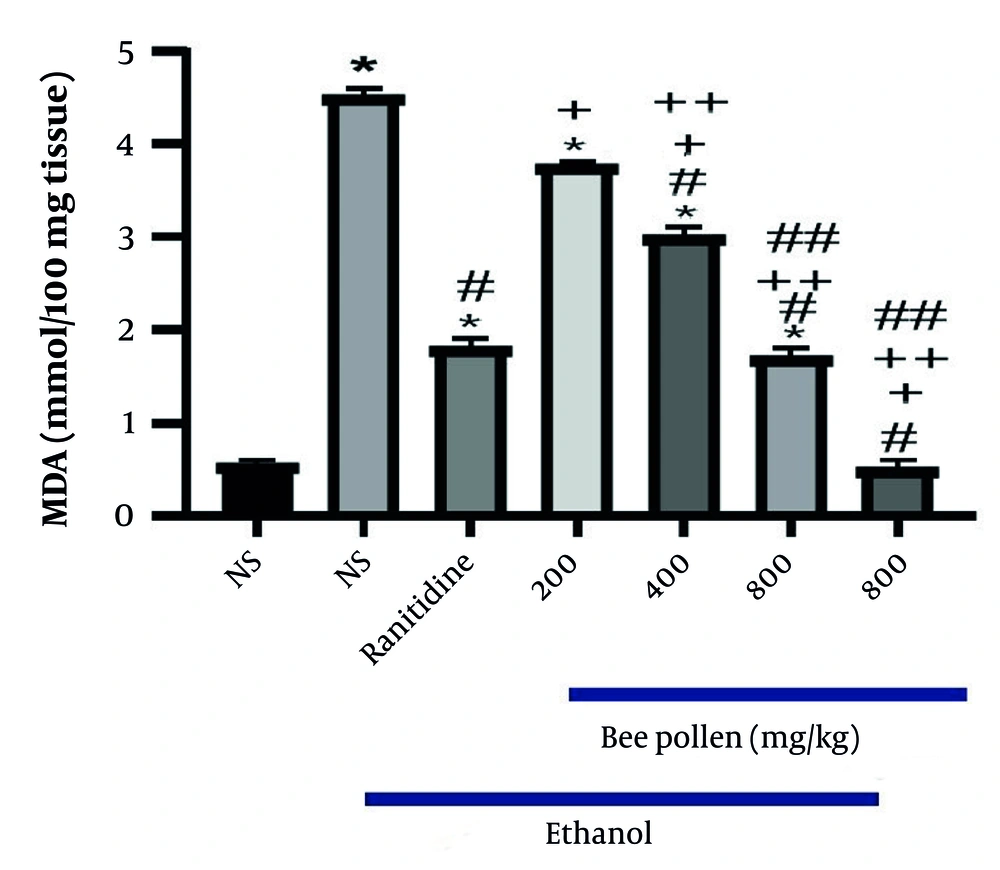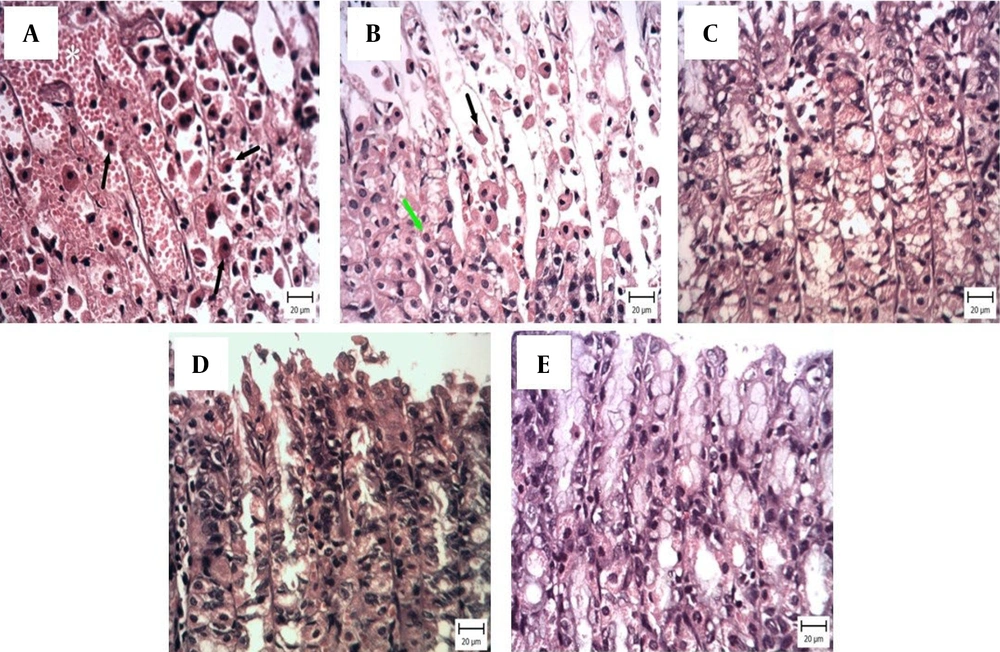1. Background
Peptic ulcer is among the most common diseases in contemporary times, marked by the presence of lesions in the gastric or duodenal mucosa (1). The formation of gastric ulcers is influenced by various factors, with Helicobacter pylori infection, alcohol consumption, smoking, and prolonged use of non-steroidal anti-inflammatory drugs being particularly significant. In rare cases, tumors in the stomach or pancreas may also cause gastric ulcers (2). One of the experimental agents causing gastric ulcers is alcohol, which exerts its effects by damaging protective mechanisms, including mucosal degradation, altered blood flow, increased free radicals, and lipid peroxidation (3).
Oxidative stress is a critical factor in many diseases. Studies have shown a direct relationship between oxidative stress-induced free radicals and gastric and duodenal ulcers. Acute ethanol administration leads to nucleic acid damage, increased xanthine oxidase activity, elevated malondialdehyde (MDA) levels, and decreased glutathione levels (4). Lipid peroxidation damages cell membranes, further releasing lysosomal enzymes and increasing tissue damage (5). Active oxygen and lipid peroxidation are also implicated in gastric ulcers induced by alcohol, suggesting that antioxidants could play a protective role (6).
Bee Pollen is a natural compound that has been studied for its effects in traditional medicine over the past decade. It is essentially a collection of pollen grains mixed with nectar and bee saliva, forming a uniform substance. Research indicates that Bee Pollen is used as a food source throughout the growth stages of bees (7). It contains carbohydrates, fiber, lipids, essential amino acids, and flavonoids such as myricetin (8). The composition of Bee Pollen varies based on the plants from which it is collected, as well as local climate and soil conditions (9).
Bee Pollen is a fine grain located at the tip of the flower's stamen and is the sole factor for fertilizing the plant. Honeybees collect it in small pellets on their hind legs, storing it in a special pouch to meet their protein and vitamin needs, as well as those of their larvae, and then transport it into the hive. In areas where Bee Pollen is abundant, beekeepers install pollen traps in the flight paths of the bees to collect and dry it (9).
The main components of Bee Pollen are protein (35%), carbohydrates (40%), and water (5%), with 20% consisting of compounds that are not fully understood (10). Researchers have conducted studies to determine the medicinal effects of Bee Pollen on various diseases. It has been established that Bee Pollen contains sexual hormones that act as general stimulants for treating certain conditions in various clinics and hospitals in Europe and East Asia (11). Bee Pollen has been effective in treating neurological disorders, with individuals reporting improved mood and activity levels after a week of consumption (10). Additionally, it has shown promise in managing diabetes symptoms and has significant effects on prostatitis, infertility, and male sexual dysfunction due to its high zinc content. It enhances circulation, increases physical and mental performance, particularly in older individuals, and prevents excessive fatigue (12).
One of the most notable properties of Bee Pollen is its ability to strengthen the immune system. Due to its rich content of vitamins, minerals, proteins, and antioxidants, it combats free radicals that damage cells (13). Furthermore, its specific beneficial compounds help maintain emotional balance, increase physical energy, and enhance resilience against daily stressors. Athletes believe that Bee Pollen improves their speed and agility, providing sufficient energy for training (10). In ancient times, Egyptians and Chinese regarded Bee Pollen as a source for preserving youth. Modern research confirms its benefits, as it positively impacts physical health and enhances skin, hair, and overall appearance. Bee Pollen also supports memory, concentration, and cognitive abilities, making it potentially beneficial for the elderly (11).
Many medications for preventing and treating gastric ulcers require long-term use, which can lead to side effects.
2. Objectives
Therefore, the discovery of natural products may mitigate the occurrence of toxic effects associated with synthetic drugs. Given the promising research on Bee Pollen and its natural active compounds, such as flavonoids, further investigation into its positive effects on gastric ulcers is warranted (13).
3. Methods
3.1. Chemicals
Bee Pollen was purchased from Ardabil province, and ethanol (96%) was obtained from Khorramshahr Company (Khorramshahr, Iran). In this study, 42 male Wistar rats weighing between 200 and 250 g were sourced from the animal house of Ahvaz Jundishapur University of Medical Sciences (Ahvaz, Iran). After weighing, the rats were randomly assigned to 7 groups of 6. They were housed in the animal facility of the Faculty of Pharmacy at a temperature of 23 ± 2°C, 50% humidity, and a 12-hour light/dark cycle. The rats were provided with specialized animal feed and municipal purified water, and their cages were designed to prevent coprophagy during hunger. Notably, the animals were allowed to acclimate to the laboratory environment for one hour prior to the experiment. This study was approved under the ethical approval code B9454 at Ahvaz Jundishapur University of Medical Sciences.
3.2. Preparation of Hydroalcoholic Extract of Bee Pollen
Bee Pollen was collected from beekeeping farms in Ardabil province. To obtain the hydroalcoholic extract of Bee Pollen (HBP), 100 grams of Bee Pollen was immersed in 1500 mL of 70% ethanol (v/v) for 72 hours. The mixture was then shaken and filtered, and the solvent was removed using a vacuum evaporator, yielding a semi-solid extract. This extract was subsequently placed in an oven at 60°C for 72 hours to complete the drying process (14).
3.3. Induction of Acute Gastric Lesion by Ethanol
Gastric ulcers were induced by administering 96% ethanol orally at a dose of 5 mL/kg. One hour after ethanol administration, the animals were anesthetized via intraperitoneal injection of ketamine (80 mg/kg) and xylazine (10 mg/kg). The stomachs were then carefully dissected and opened along the greater curvature to assess the number and length of gastric lesions (15). A segment of the stomach was further dissected and homogenized in cold potassium phosphate buffer (0.05 M, pH 7.4). The homogenate was centrifuged at 5000 rpm for 10 minutes, and the resulting supernatant was stored at -80°C for future measurement of MDA (14).
3.4. Experimental Design
The animals were randomly categorized into the following groups: Vehicle group (normal saline + normal saline), ethanol group (normal saline + ethanol), treatment group (HBP + ethanol), positive control group (ranitidine + ethanol), and a control group that received HBP (800 mg/kg) without ethanol administration (16). The treatment groups received HBP orally at doses of 200, 400, and 800 mg/kg.
3.5. Determination of Malondialdehyde in Gastric Mucosa
The level of lipid peroxidation was assessed by measuring MDA using a colorimetric assay kit (ZellBio GmbH, Ulm, Germany) according to the manufacturer's instructions. This involved measuring thiobarbituric acid (TBA)-reactive substances at a wavelength of 535 nm.
3.6. Histopathological Examination
For histopathological analysis, stomach tissues were fixed in a 10% buffered formalin solution and embedded in paraffin. The sections were deparaffinized and stained with hematoxylin and eosin (H&E).
3.7. Statistical Analysis
Data were presented as mean ± SEM. Comparisons between the means of different groups were conducted using one-way analysis of variance (ANOVA), followed by Tukey’s post hoc test. A significance level of P < 0.05 was considered statistically significant. All statistical analyses were performed using GraphPad Prism software, version 5 (GraphPad Software, Inc., San Diego, CA, USA).
4. Results
4.1. Effect Hydroalcoholic Extract of Bee Pollen on Ethanol-Induced Gastric Lesions
Research indicated that the administration of ethanol (96%) resulted in the development of extensive and hemorrhagic gastric ulcers in rats. Oral pretreatment with HBP significantly reduced both the number and length of gastric lesions in a dose-dependent manner (P < 0.05) (Figures 1, 2A and B). Among the doses tested, the highest dose of HBP (800 mg/kg) exhibited the most substantial inhibitory effect on the number and length of the ulcers. Additionally, ranitidine (50 mg/kg) and HBP (800 mg/kg) demonstrated similar effects on ulcer counts and lengths. Furthermore, high doses of HBP (800 mg/kg) alone did not produce any adverse effects on stomach tissue.
The gross appearance of gastric ulcers induced by ethanol (5 mL/kg) and protective effects of hydroalcoholic extract of bee pollen (HBP) (200, 400, or 800 mg/kg). A, normal saline + normal saline; B, normal saline + ethanol; C, ethanol + HBP (200 mg/kg); D, ethanol + HBP (400 mg/kg); E, ethanol + HBP (800); and F, ethanol + ranitidine (50 mg/kg). Ethanol caused extensive hemorrhagic ulcers (B) and treatment with HBP at dose of 800 mg/kg attenuated gastric ulcers.
The effect of hydroalcoholic extract of bee pollen (HBP) (200, 400, or 800mg/kg) on the A, number; and B, length of gastriculcers (in mm) induced by ethanol. Values are expressed as mean ± S.E.M. (n = 6). * P < 0.05 compared to the normal saline (NS). # P < 0.05 compared to the normal saline and ethanol. + P < 0.05 compared to the ranitidine. ++ P < 0.05 compared to the HBP (200 mg/kg). ## P < 0.05 compared to the HBP (400 mg/kg).
4.2. Effect of Hydroalcoholic Extract of Bee Pollen on Malondialdehyde Level in Gastric Tissue
Figure 3 illustrates that ethanol administration significantly raised gastric MDA levels compared to the normal saline group (P < 0.05). In contrast, treatment with HBP at a dose of 800 mg/kg produced a significant reduction in MDA levels in the gastric tissue, demonstrating effects similar to those of ranitidine (P < 0.05).
Effect of hydroalcoholic extract of bee pollen (HBP) (200, 400, or 800 mg/kg) on the levels of malondialdehyde (MDA) in gastric tissues. Values are expressed as mean ± S.E.M.; (n = 6). * P < 0.05 compared to the normal saline (NS). # P < 0.05 compared to the normal saline and ethanol. + P < 0.05 compared to the ranitidine. ++ P < 0.05 compared to the HBP (200 mg/kg). ## P < 0.05 compared to the HBP (400 mg/kg).
4.3. Histopathology
Microscopic examination of the gastric tissue revealed multiple ulcers on the mucosal surface in the group receiving physiological serum with ethanol. A significant number of erythrocytes were observed in these areas, indicating bleeding. In these areas, the surface mucous cells of the gastric mucosa and gastric glands were necrotic, with condensed and dark nuclei and more intensely stained cytoplasm compared to adjacent healthy cells. Additionally, these cells were seen detached within the gastric gland ducts and among the erythrocytes, with erythrocytes observed down to the depth of the gastric pits (Figure 4A). Severe edema was observed in the submucosa, characterized by numerous empty spaces between the connective tissue fibers.
In the treatment group receiving 200 mg/kg of HBP, ulcers were observed but were less deep, and bleeding and submucosal edema were also observed to a lesser extent (Figure 4B). Microscopic examination of the gastric mucosa in the group receiving 400 mg/kg of HBP showed a broader area of intact mucosa (Figure 4C). Few ulcerative lesions were observed that were much shallower compared to the ethanol group. Examination of the gastric mucosa in the group receiving 800 mg/kg of HBP extract indicated intact mucosa in most areas (Figure 4D). In the microscopic examination of the group receiving ranitidine with ethanol, no bleeding or necrosis of the gastric mucosa was observed, and the epithelial cells and gland walls were healthy (Figure 4E).
Protective effects of hydroalcoholic extract of bee pollen (HBP) (200, 400, or 800 mg/kg) on histopathological changes of gastric tissue induced by ethanol (hematoxylin and eosin staining, magnification ×100). A, Normal saline and ethanol; B, ethanol and pretreatment with 200 mg/kg HBP; C, ethanol and pretreatment with 400 mg/kg HBP; D, ethanol and pretreatment with 800 mg/kg HBP; E, ethanol and ranitidine (50 mg/kg). The results showed: A, note to hemorrhage (asterisk), epithelial cell necrosis (arrows), and desquamation of them which are indicators of gastric ulcer; B, massive area of hemorrhage and necrosis of the epithelium (arrows); C, note to necrotic cells (arrow) and normal cell (white asterisk); D, note to normal desquamation of epithelial cells (arrow) and normal glandular cells; E, note to normal epithelial cells (arrow) and normal glandular cells.
5. Discussion
Gastrointestinal diseases, including gastric ulcers, are prevalent and have been the subject of numerous studies. Many investigations have focused on methods to prevent gastric ulcers (17). Ethanol-induced gastric ulcers are one of the peptic ulcer models widely used to examine the gastroprotective properties of various substances in laboratory settings (18). The pathogenesis of ethanol-induced gastric ulcers is multifactorial, involving factors such as necrosis of surface cells and the production of superoxide anions and free radicals through ethanol metabolism in the body. These mediators lead to reduced microvascular blood flow to the gastric mucosa and ultimately result in mucosal damage. Additionally, ethanol disrupts the integrity of the gastric mucosa by interfering with the production of gastric mucosal surfactant (19). Ethanol can reduce the secretion of bicarbonate and gastric mucus. Furthermore, ethanol decreases mucosal blood flow, induces oxidative stress, increases the production of xanthine oxidase and malondialdehyde, and decreases glutathione production (20).
Various studies have been conducted to identify new gastroprotective agents against oxidative inflammatory conditions induced by ethanol in the stomach (15). Thus, attention to natural substances aims to achieve drugs with minimal side effects. The current study aimed to investigate the therapeutic effects of Bee Pollen on ethanol-induced gastric ulcers in rats. Bee Pollen is essentially a collection of pollen particles bound together by nectar and the saliva of honeybees (21). Additionally, Bee Pollen is an abundant source of hydrophilic antioxidants that safeguard against oxidative stress in the cytoplasm, intracellular organelles, and extracellular fluid. Notable among these hydrophilic antioxidants are compounds like ascorbate (vitamin C) and phenolic acids, which have been isolated (22).
Flavonoids comprise a large group of substances containing 5,000 different compounds with a wide range of biological effects. Various mechanisms for their gastric healing effects have been proposed, including increased prostaglandin levels, increased gastric mucus, reduced histamine secretion from mast cells by inhibiting the enzyme histidine decarboxylase, scavenging free radicals, and inhibiting the growth of Helicobacter pylori (23). Vitamin C derived from Bee Pollen can reduce reactive oxygen species. It has also been shown that Bee Pollen can produce a suitable level of nitric oxide, which can relax arteriolar smooth muscles. The relaxation of arteriolar smooth muscles is one of the most important factors responsible for regulating gastric mucosal blood flow (24). This may explain the protective effects of HBP on the histopathological characteristics of ethanol-induced gastric ulcers.
Although HBP exhibits protective tissue effects, the molecular and cellular mechanisms behind these effects remain incompletely understood. However, it is likely that Bee Pollen alleviates inflammatory and oxidative conditions and releases mediators such as nitric oxide, leading to vascular vasodilation and increased blood supply to the damaged area, thereby accelerating gastric ulcer healing (22). The present study demonstrated that HBP can significantly reduce the number of ulcers, ulcer length, and MDA levels as a primary marker of lipid peroxidation in the stomach of rats in a dose-dependent manner.
The results of this study align with research conducted by other investigators. For example, Eraslan et al. in 2008 demonstrated that Bee Pollen acts as an anti-lipoprotein peroxidant, with the bioflavonoids present in Bee Pollen inhibiting free radicals, leading to a reduction in MDA levels and an increase in antioxidant enzyme levels (25). Sarić et al. in 2009 examined the antioxidant and anti-estrogenic effects of flavonoids in Bee Pollen in mice. The results showed that Bee Pollen is a vast source of antioxidants and has high potential for protecting the body and maintaining the health of various organs (26). Jue in 1989 studied the anti-aging effects of Bee Pollen compounds. In this study, for two months, 10 grams of pollen were given daily to old mice, and parameters such as liver and heart tissue health and lipid levels were examined, finding that Bee Pollen reduced tissue degradation and aging (27). Leja et al. in 2007 investigated the antioxidant properties in 12 species of Bee Pollen and found that all species contained significant amounts of phenolic compounds with antioxidant properties, revealing that daily intake of Bee Pollen in these mice compared to the control group could have a significant impact on maintaining the health of various organs (28).
In the present study, the effects of doses of 200 mg/kg, 400 mg/kg, and 800 mg/kg of HBP on ethanol-induced gastric ulcers in rats were examined. Factors such as the number of ulcers, ulcer length, and MDA levels were evaluated. The results and pathological and laboratory data assessments indicated that the protective effect of this extract is likely due to the elimination of free radicals and the natural protection of cells. The dose of 800 mg/kg of HBP was selected as the optimal dose for controlling various factors.
5.1. Conclusions
The present study showed that HBP has a therapeutic effect on ethanol-induced gastric ulcers. HBP can significantly reduce the elevated levels of MDA caused by ethanol. Notably, all tissue protective effects and antioxidant properties of Bee Pollen are dose-dependent. The results suggest that HBP may serve as an adjunct or primary treatment for gastric ulcer prevention, pending further studies on various animal models and adherence to existing regulations and guidelines for human trials.




